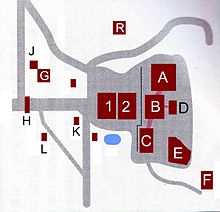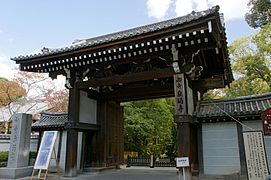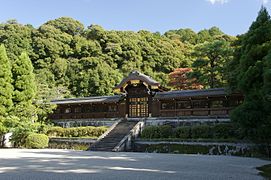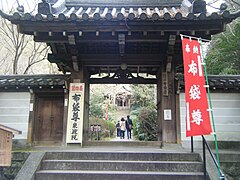Sennyu-ji
The Sennyū-ji ( Japanese 泉涌 寺 , also Mitera ( 御寺), Senzan ( 泉山 )) is a temple of the Sennyūji branch of Shingon . It is located on a long slope below Mount Senzan on the southeastern edge of the city of Kyoto . The second syllable of the name indicates a source that is still present on the temple grounds today.
history
The construction of the temple is said to have started with the precursor built by Kūkai , the simple Hōrin-ji ( 法輪 寺 ). According to another tradition, in the year 856 at the request of Fujiwara no Otsugu ( 藤原 緖 嗣 ; 774-843) high priest Shinshū ( 神 修 ) the Hōrin-ji converted the temple with the name Sennyū-ji ( 仙遊 寺 ). Thereafter there is said to have been a decline, until then in 1218 priest Nobufusa ( 信 房 ) entrusted the priest Shunjō ( 俊 芿 , posthumously Garin Daishi ( 月 輪 大師 ); 1166-1227) with the temple. Since a clear spring was bubbling on the temple grounds, he now wrote the temple Sennyū-ji with the yū meaning bubbling. At that time the temple was worshiped within the framework of Tendai-shu , Shigon, Ritsu and Zen , the temple was doing well. Shunjō, who had many followers as a priest, wrote the Sennyū Kan'enso ( 泉湧 寺 勧 縁 疏 ; national treasure ), which he dedicated to Emperor Go-Toba in retirement. He was supported by the imperial court and the nobility, so that the temple became the prayer temple of the imperial family ( 勅 願 寺 , Chokuganji) in 1224 . The temple also flourished under Shunjō's successor, Tankai, so that the temple became the burial place of the imperial family.
Since 1242, Emperor Shijō was laid out in the vicinity of the temple for the respective emperors, until Emperor Go-Kōgon was cremated there as the ninth in 1374 . In the Ōnin War , soldiers set fires that burned down the entire temple. After that, Oda Nobunaga and Toyotomi Hideyoshi supported the reconstruction, but the Buddha Hall could not be rebuilt until 1668.
The attachment
The temple grounds begin with the outer gate ( 総 門 , Sōmon). Once you have passed the gate, the sub-temple Sokujō-in ( 即成 院 ), also Sokujōju-in ( 即 成就 院 ), which was moved here from Fushimi in 1902 , extends to the left . There is the tomb of Fujiwara no Toshitsuna ( 藤原 俊 綱 ; 1028-1094), the founder of the Tachibana family. As in the case of Nasu Yoichi ( 那 須 与 市 ; 1169–1190), the graves are decorated with large stone treasure pagodas. In the main hall of the temple, Amida Nyorai, who is surrounded by 25 bosatsu, is worshiped. The 16 statues that are considered to be inherited from Fushimi-ji are registered as important cultural assets, marked with ◎ below . The celebration called Narikuyō ( 練 ik ) takes place on the 2nd Sunday in October . The statues are carried over an annual bridge path. - At this temple is the grave of Itō Kashitarō ( 伊 東 甲子 太郎 ; 1835–1867), a samurai who was initially an advisor to the Shinsengumi ( 新 選 組 ) group, loyal to the shogunate , but then joined the movement loyal to the emperor and was then murdered .
Further up, surrounded by green, is the lower temple, the Raigo-in ( 来 迎 院 ; R). Every year on the 2nd Monday in January, that is, on the national holiday , the temple takes part in the veneration of the Senzan seven gods of fortune as the fourth station with the Hotei .
Further up you come to the main gate ( 大門 Daimon ; H; ◎) from the Momoyama period , which stands at the highest point of the temple area. On the left you pass the Yōkihikannon-dō ( 楊貴妃 観 観 音 堂 ; J), a small building in which a seated Yōkihikannon (◎) is worshiped. There are three rakan on their right and left . Next to it is the Shinshōden ( 心照 殿 ; G), a recent building with exhibitions on Buddhism. - On the right side behind the gate are the sutras ( 経 蔵 Kyōzō ; L) and the bathhouse ( 浴室 Yokushitsu ; K).
The Buddha Hall ( 仏 殿 Butsuden ; 1; ◎) from 1668 is built in the Zen style. It houses a statue of Amida Buddha in its center, flanked by two companions. - Behind the Buddha hall is the reliquary hall ( 舎 利 殿 Shariden ; 2) from the Edo period, built in the same style . Inside is a gold-plated treasure pagoda ( 宝塔 , Hōtō) from the Kamakura period.
In the rear, separated area of the temple is the abortion residence ( 方丈 Hōjō ; A). Next to it is the relaxation hall ( 御座 所 Gozasho , B). It was rebuilt in the same year after a fire in 1882. It serves the imperial family while visiting the graves of the ancestors in the burial place ( Mauer 輪 陵 Tsuki no Misasagi ; E) of several emperors, from Emperor Shijō and Go-Mizunoo to Emperor Ninkō . The Memorial Hall ( 霊 明 殿 Reimeiden ; C) was moved here from the Imperial Palace in Kyoto. It contains steles that commemorate various emperors. The small hall Kaikaidō ( 海 会堂 ; D) with a square floor plan is also said to have been moved here from the Imperial Palace.
A little outside of this temple area is the temple founder hall ( 開山 堂 Kaisandō ; F; ◎) with a square floor plan. It was built in the Kambun period (1641–1677) for priest Shunjō.
Treasures of the temple
In addition to the Sennyū Kan'enso mentioned, the painting (colored on silk) of the Zen priest Wuzhun ( 無 準 ; 1177-1248; Song Dynasty ) and, among the writings of Wuzhun, a petition for donations ( 附 法 状 Tsuketari ) are shown as national treasures hōjō ; 1227).
The important cultural assets include sculptures, numerous paintings and writings.
photos
Remarks
- ↑ The red flag and the sign point to Hotei.
literature
- Kyoto-fu rekishi isan kenkyukai (Ed.): Sennyu-ji . In: Kyoto-fu no rekishi sampo (chu) . Yamakawa Shuppan, 2011, ISBN 978-4-634-24726-0 .
- Suzuki, Toshihiko (Ed.): Sennyu-ji . In: NIhon daihyakka zensho (Denshibukku-han) . Shogakukan, 1996.
Web links
- Site of the temple
- Temple Sennyu-ji at Culture-in-Asia: Part 1 with description - Part 2 - Part 3
Coordinates: 34 ° 58 ′ 41 ″ N , 135 ° 46 ′ 50 ″ E








